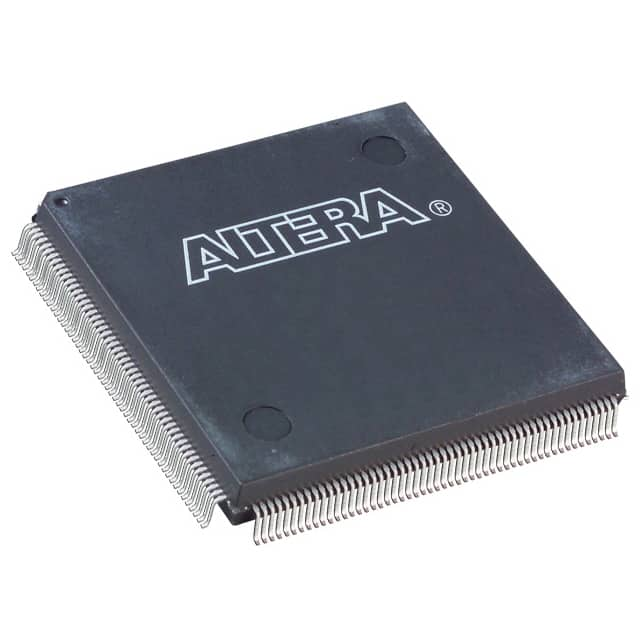Viz Specifikace pro podrobnosti o produktu.

EPF10K50SQC208-2
Product Overview
Category: Programmable Logic Device (PLD)
Use: The EPF10K50SQC208-2 is a PLD designed for digital logic applications. It provides flexible and customizable logic functions, making it suitable for a wide range of electronic systems.
Characteristics: - High-density integration - Low power consumption - Fast performance - Reconfigurable design
Package: The EPF10K50SQC208-2 comes in a 208-pin quad flat package (QFP), which allows for easy installation and connection to other components on a printed circuit board (PCB).
Essence: This PLD is based on the field-programmable gate array (FPGA) technology, which enables users to program and reprogram the device according to their specific requirements.
Packaging/Quantity: The EPF10K50SQC208-2 is typically sold individually or in small quantities, packaged in anti-static bags to prevent damage during transportation and storage.
Specifications
- Logic Elements: 50,000
- Maximum User I/Os: 182
- Embedded Multiplier Blocks: 20
- Block RAM Bits: 1,152,000
- Maximum Operating Frequency: 200 MHz
- Supply Voltage: 3.3V
- Package Type: SQC208
Pin Configuration
The EPF10K50SQC208-2 has a total of 208 pins, each serving a specific function. Here is a brief overview of the pin configuration:
- Pin 1: VCCIO - Power supply for input/output buffers
- Pin 2: GND - Ground reference
- Pin 3: TCK - Test clock input
- Pin 4: TMS - Test mode select input
- Pin 5: TDI - Test data input
- Pin 6: TDO - Test data output
- ...
- Pin 208: VCCINT - Internal power supply
For a detailed pin configuration diagram, please refer to the datasheet provided by the manufacturer.
Functional Features
The EPF10K50SQC208-2 offers several functional features that enhance its usability and performance:
- Reconfigurability: The device can be programmed and reprogrammed multiple times, allowing for flexibility in adapting to changing system requirements.
- High Integration: With 50,000 logic elements and various embedded blocks, it provides a high level of integration, reducing the need for additional components.
- Fast Performance: The PLD operates at a maximum frequency of 200 MHz, enabling rapid execution of complex logic functions.
- Low Power Consumption: The EPF10K50SQC208-2 is designed to minimize power consumption, making it suitable for battery-powered applications.
Advantages and Disadvantages
Advantages: - Flexibility in design due to reprogrammability - High integration reduces component count and board space - Fast performance enables efficient execution of complex logic functions - Low power consumption extends battery life in portable devices
Disadvantages: - Higher cost compared to fixed-function integrated circuits - Limited availability of alternative models with similar specifications
Working Principles
The EPF10K50SQC208-2 utilizes FPGA technology, which consists of an array of configurable logic blocks (CLBs) interconnected through programmable interconnects. These CLBs can be programmed to implement various logic functions, such as AND, OR, and XOR gates, as well as more complex functions like multiplexers and flip-flops.
The device's working principle involves configuring the CLBs and interconnects using a hardware description language (HDL) or a graphical design tool. Once programmed, the PLD can perform the desired logic operations based on the input signals received.
Detailed Application Field Plans
The EPF10K50SQC208-2 finds applications in various fields, including:
- Communications: Used in networking equipment, routers, and switches for data processing and protocol handling.
- Industrial Automation: Employed in control systems, robotics, and programmable logic controllers (PLCs) for process automation and monitoring.
- Consumer Electronics: Integrated into smart devices, gaming consoles, and multimedia systems for high-speed data processing and user interface control.
- Medical Devices: Utilized in medical imaging equipment, patient monitoring systems, and laboratory instruments for data acquisition and processing.
Alternative Models
While the EPF10K50SQC208-2 offers unique features, there are alternative models available with similar capabilities. Some notable alternatives include:
- Xilinx XC9500XL series
- Altera MAX 7000 series
- Lattice ispMACH 4000ZE series
These alternative models provide comparable functionality and can be considered
Seznam 10 běžných otázek a odpovědí souvisejících s aplikací EPF10K50SQC208-2 v technických řešeních
Sure! Here are 10 common questions and answers related to the application of EPF10K50SQC208-2 in technical solutions:
Q: What is EPF10K50SQC208-2? A: EPF10K50SQC208-2 is a programmable logic device (PLD) manufactured by Intel (formerly Altera). It is part of the MAX® 7000 series and offers 10,000 usable gates.
Q: What are the typical applications of EPF10K50SQC208-2? A: EPF10K50SQC208-2 can be used in various applications such as industrial automation, telecommunications, automotive systems, medical devices, and consumer electronics.
Q: What are the key features of EPF10K50SQC208-2? A: Some key features include 5V tolerant I/O pins, high-speed performance, on-chip memory, JTAG programming interface, and low power consumption.
Q: How can EPF10K50SQC208-2 be programmed? A: EPF10K50SQC208-2 can be programmed using the Quartus® II software provided by Intel. The programming file can be loaded onto the device using a JTAG programmer.
Q: Can EPF10K50SQC208-2 be reprogrammed multiple times? A: Yes, EPF10K50SQC208-2 is a reprogrammable device. You can erase and reprogram it multiple times as per your requirements.
Q: What is the maximum operating frequency of EPF10K50SQC208-2? A: The maximum operating frequency of EPF10K50SQC208-2 depends on the specific design and implementation. It can typically operate at frequencies up to 200 MHz.
Q: Does EPF10K50SQC208-2 support external memory interfaces? A: Yes, EPF10K50SQC208-2 supports various external memory interfaces such as SDRAM, SRAM, Flash, and EEPROM. It provides dedicated pins for interfacing with these memories.
Q: Can EPF10K50SQC208-2 communicate with other devices or microcontrollers? A: Yes, EPF10K50SQC208-2 can communicate with other devices using standard communication protocols such as SPI, I2C, UART, and CAN. It has configurable I/O pins for this purpose.
Q: What is the power supply requirement for EPF10K50SQC208-2? A: EPF10K50SQC208-2 operates on a single power supply of 3.3V. However, it also supports 5V tolerant I/O pins for compatibility with older systems.
Q: Are there any development boards available for EPF10K50SQC208-2? A: Yes, Intel provides development boards like the DE1 series that are compatible with EPF10K50SQC208-2. These boards come with pre-built circuits and peripherals for easy prototyping and testing.
Please note that the answers provided here are general and may vary based on specific design requirements and application scenarios.

